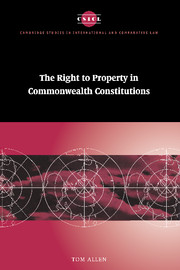Book contents
- Frontmatter
- Contents
- Table of cases
- Acknowledgements
- 1 Introduction
- 2 The right to property at common law
- 3 The development of written rights to property
- 4 Constitutional interpretation
- 5 The meaning of property
- 6 Acquisition and deprivation
- 7 Public purpose
- 8 Compensation
- Bibliography
- Index
- CAMBRIDGE STUDIES IN INTERNATIONAL AND COMPARATIVE LAW
3 - The development of written rights to property
Published online by Cambridge University Press: 28 July 2009
- Frontmatter
- Contents
- Table of cases
- Acknowledgements
- 1 Introduction
- 2 The right to property at common law
- 3 The development of written rights to property
- 4 Constitutional interpretation
- 5 The meaning of property
- 6 Acquisition and deprivation
- 7 Public purpose
- 8 Compensation
- Bibliography
- Index
- CAMBRIDGE STUDIES IN INTERNATIONAL AND COMPARATIVE LAW
Summary
Introduction
The fundamental rule of English law that property could be taken only for a public purpose and on payment of compensation eventually found its way into the written constitutions of most Commonwealth states. The development of rights to property has been somewhat disjointed, as some constitutions reflect the style of drafting of the Fifth and Fourteenth Amendments of the United States Bill of Rights, while many others are based on early Indian legislation. Some important elements of recent constitutions borrow heavily from the European Convention on Human Rights, and the Irish and German constitutions have been influential on the drafting of Commonwealth rights to property. Consequently, the style, detail and structure of rights to property vary considerably across the Commonwealth.
This chapter therefore describes the different formulations of written rights to property in the Commonwealth. Unlike the remaining chapters of this book, it concentrates on the framing and drafting of constitutions rather than their subsequent interpretation by the judiciary. It begins with the protection of property under the federal constitutions of Canada and Australia. While these constitutions do not contain rights to property, they do reflect the idea of constitutional supremacy and the importance of limiting legislative power. In Australia, in particular, the conferral on the Commonwealth of a limited power to acquire property has had the same effect as the entrenchment of a right to property.
It then considers the early formulations of rights to property in the Government of Ireland Act 1920.
- Type
- Chapter
- Information
- The Right to Property in Commonwealth Constitutions , pp. 36 - 82Publisher: Cambridge University PressPrint publication year: 2000



